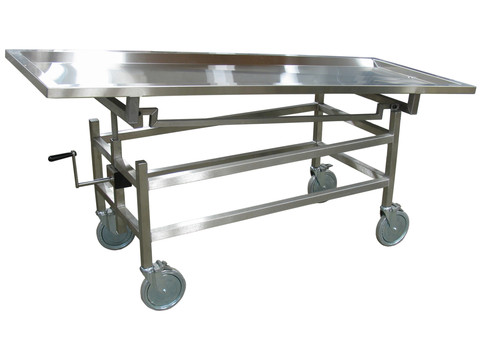-


-
Transfer mortuary trolley
The mortuary body transfer trolley, as a key device connecting the dignity of life and the funeral process, carries a deep mission beyond physical transportation. From hospitals to grassroots funeral homes, from forensic appraisal centers to disaster emergency sites, these "life shuttle buses" made of 304 stainless steel material are designed with precision, humanized functions, and strict hygiene standards to build a professional closed loop for body handling.
-
0.000.00
-
The mortuary body transfer trolley, as a key device connecting the dignity of life and the funeral process, carries a deep mission beyond physical transportation. From hospitals to grassroots funeral homes, from forensic appraisal centers to disaster emergency sites, these "life shuttle buses" made of 304 stainless steel material are designed with precision, humanized functions, and strict hygiene standards to build a professional closed loop for body handling.
1、 Functional Features: Multidimensional Considerations in Professional Design 1.1 Integration of structural mechanics and ergonomics The modern mortuary handcart adopts a modular design concept, with the main frame welded from 304 stainless steel square tubes, ensuring a load-bearing capacity of over 180kg. The introduction of the double fork hydraulic lifting system enables a single person to smoothly transfer the body from the hospital bed to the trolley, avoiding secondary damage that may occur with traditional transportation methods. 1.2 Comprehensive Construction of Health Protection System In response to the infection control requirements during the transportation of corpses, the surface of the trolley is polished with a mirror finish, which increases the cleaning and disinfection efficiency by 40%. Combined with a detachable stainless steel tray design, achieve a standardized process of "one use, one consumption". Some high-end models are also equipped with biosafety sealing covers, which are combined with silicone sealing strips and transparent PC boards to form a three-level protective barrier during the transportation of infectious disease bodies, effectively blocking the risk of body fluid splashing. 1.3 Penetration and application of intelligent technology With the development of Internet of Things technology, electric driven carts have become popular. Intelligent corpse transport vehicle, equipped with 24V DC motor and lithium battery pack, achieves silent driving and precise speed control. The electronic braking system it is equipped with can respond to hill parking requirements within 0.2 seconds, ensuring transportation safety. More noteworthy is that some products have integrated RFID recognition modules, which can automatically record body information and transportation trajectories, providing data support for the informatization of funeral management. 2、 Technological Evolution: From Basic Tools to Professional Equipment 2.1 Breakthrough Applications in Materials Science Early carts were mostly made of carbon steel material, which had defects such as easy corrosion and heavy weight. After 2015, 304 stainless steel gradually became the mainstream choice, with its chloride corrosion resistance three times higher than traditional materials, and its service life extended to more than 10 years. 2.2 Continuous optimization of ergonomics In response to the occupational health needs of funeral workers, the trolley design has undergone three major innovations: the rotatable handle design launched in 2018, which allows operators to adjust the grip angle according to their height; The shock-absorbing spring system applied in 2021 effectively filters the impact of ground bumps on the body; The electric power steering system, which will be launched in 2024, reduces the steering torque by 75% and significantly reduces the labor intensity of workers. These improvements have reduced the average transit time from 8 minutes to 3 minutes and increased work efficiency by 62.5%. 2.3 Innovative Practice of Modular Design To meet the needs of different scenarios, modern carts adopt a combination of "core framework+functional modules". Its basic frame can be matched with more than 20 accessories such as refrigerators, dissecting tables, disinfection devices, etc., achieving "one vehicle for multiple uses". 3、 Application scenario: Professional services covering the entire chain 3.1 Standardized processes within medical institutions In the hospital morgue, carts are responsible for the crucial transportation task from the ward to the morgue. 3.2 Professional Operations in Funeral Services Funeral parlors have more diverse functional requirements for carts. 3.3 Special Applications in Emergency Rescue In emergencies such as natural disasters and traffic accidents, carts need to have the ability to deploy quickly and integrate multiple functions. The development history of the mortuary body transfer trolley is an evolutionary history intertwined with technology and humanities. From simple transportation vehicles to specialized equipment that integrates mechanics, materials science, and electronics, every technological breakthrough embodies a reverence for the dignity of life. In the current context of accelerated population aging and frequent emergencies, this special medical equipment is assuming increasingly important social functions. In the future, with the deep integration of artificial intelligence and Internet of Things technology, carts will achieve a leap from "functional carriers" to "intelligent platforms", continuing to write a new chapter in technology and humanities on the path of safeguarding the end of life.

Wooden coffin
Metal Caskets
tombstone
Funeral equipment
Urn
cinerary casket
Hebei Xubing International Trade Co., Ltd
Room 101, Unit 5, Building 4, Five-Star Industrial Park, No. 120 Wind Energy Street, Baoding







